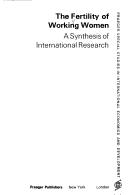| Listing 1 - 4 of 4 |
Sort by
|
Book
ISBN: 0691093717 132288384X 0691616663 0691643911 1400871751 9780691093710 Year: 1977 Publisher: Princeton (N.J.): Princeton university press,
Abstract | Keywords | Export | Availability | Bookmark
 Loading...
Loading...Choose an application
- Reference Manager
- EndNote
- RefWorks (Direct export to RefWorks)
Here is the full report of the 1970 National Fertility Study, a national sample survey for which thousands of women were interviewed who had been married at some time and were of reproductive age when they were interviewed. The book assesses the growth in the use of the pill and the IUD, the increasing reliance on contraceptive sterilization, and both the intended and the unwanted fertility of American women. The volume opens with an introduction to the survey and its methods. Contraceptive practice in 1970 is then compared with data for 1965, and an analysis is supplied of trends since 1955 in the attitudes of Roman Catholics.Originally published in 1977.The Princeton Legacy Library uses the latest print-on-demand technology to again make available previously out-of-print books from the distinguished backlist of Princeton University Press. These editions preserve the original texts of these important books while presenting them in durable paperback and hardcover editions. The goal of the Princeton Legacy Library is to vastly increase access to the rich scholarly heritage found in the thousands of books published by Princeton University Press since its founding in 1905.
-Contraception --- -Fertility, Human --- -Human fertility --- -Vruchtbaarheid. Nataliteit --(demografie) --- Family Planning Services --- Birth control --- Contraception --- Fertility, Human --- 314.3 --- Conception --- Reproductive rights --- 314.3 Vruchtbaarheid. Nataliteit --(demografie) --- Vruchtbaarheid. Nataliteit --(demografie) --- Prevention --- Fertility. --- Régulation des naissances --- Birth control - United States --- Fertility, Human - United States --- Contraception - United States
Book
ISBN: 0691052530 1322883661 0691616183 1400870038 0691643490 9780691052533 Year: 1977 Volume: 4 Publisher: Princeton (N.J.): Princeton university press,
Abstract | Keywords | Export | Availability | Bookmark
 Loading...
Loading...Choose an application
- Reference Manager
- EndNote
- RefWorks (Direct export to RefWorks)
Fertility in Belgium declined early and remained low compared with that in other European countries. For this reason, and because of the nation's heterogeneity, study of its demographic transition illuminates the relationship between fertility behavior and socioeconomic development. Professor Lesthaeghe first describes the Belgian experience in a way that permits direct comparison with that of other European nations. He then tests the several explanatory hypotheses for the European fertility decline against his data.Belgium's heterogeneity in the nineteenth-century and in the first half of the twentieth was economic, social, and cultural. Some areas of the country underwent industrialization as early as 1800-1830, while others shifted away from agriculture and artisanal modes of production only between 1880 and 1910. Between 1890 and 1900, regional fertility levels differed drastically, as did regional infant mortality rates and life expectancies at birth. In addition, wide variation occurred in the process of secularization, linguistic characteristics, demographic trends, and other cultural indicators. By describing and analyzing these data in relation to Belgium's fertility decline, Professor Lesthaeghe makes a major contribution to the theory of the demographic transition that occurred throughout Europe.Originally published in 1978.The Princeton Legacy Library uses the latest print-on-demand technology to again make available previously out-of-print books from the distinguished backlist of Princeton University Press. These editions preserve the original texts of these important books while presenting them in durable paperback and hardcover editions. The goal of the Princeton Legacy Library is to vastly increase access to the rich scholarly heritage found in the thousands of books published by Princeton University Press since its founding in 1905.
Fertility, Human --- Birth Rate --- Fertility --- Population --- History --- statistics --- 312.1 <493> --- 312 <493> --- 314.3 --- -#SBIB:314H127 --- Human fertility --- Natality --- Demography --- Human reproduction --- Infertility --- Vruchtbaarheid. Nataliteit --(demografie) --- Regionale bevolkingsstudies: Europa --- History. --- 314.3 Vruchtbaarheid. Nataliteit --(demografie) --- #SBIB:314H127 --- statistics. --- Fécondité humaine --- Histoire. --- Statistics. --- Fertility, Human - Belgium - History --- Fécondité humaine
Book
ISBN: 0521214025 Year: 1977 Publisher: New York (N.Y.) : Cambridge university press,
Abstract | Keywords | Export | Availability | Bookmark
 Loading...
Loading...Choose an application
- Reference Manager
- EndNote
- RefWorks (Direct export to RefWorks)
Sociology of the family. Sociology of sexuality --- Great Britain --- 314.3 <420> --- Family size --- -Fertility, Human --- -Birth control --- -Social surveys --- -#GBIB:IDGP --- Community surveys --- Surveys, Social --- Social sciences --- Surveys --- Population control --- Pregnancy --- Family planning --- Contraception --- Reproductive rights --- Human fertility --- Natality --- Demography --- Human reproduction --- Infertility --- Size of families --- Vruchtbaarheid. Nataliteit --(demografie)--Engeland --- Research --- Prevention --- Birth control --- Fertility, Human --- Social surveys --- 314.3 <420> Vruchtbaarheid. Nataliteit --(demografie)--Engeland --- #GBIB:IDGP

ISBN: 0275231003 9780275231002 Year: 1977 Publisher: New York (N.Y.): Praeger,
Abstract | Keywords | Export | Availability | Bookmark
 Loading...
Loading...Choose an application
- Reference Manager
- EndNote
- RefWorks (Direct export to RefWorks)
Fertility, Human --- Women --- Employment --- 316.356.2 --- 314.3 --- -#SBIB:316.356.2H1540 --- #SBIB:316.356.2H3620 --- Human females --- Wimmin --- Woman --- Womon --- Womyn --- Females --- Human beings --- Femininity --- Human fertility --- Natality --- Demography --- Human reproduction --- Infertility --- Gezinssociologie --- Vruchtbaarheid. Nataliteit --(demografie) --- Gezin en buitenhuisarbeid van de vrouw: algemeen --- Gezinssociologie: vruchtbaarheid: algemeen --- 314.3 Vruchtbaarheid. Nataliteit --(demografie) --- 316.356.2 Gezinssociologie --- #SBIB:316.356.2H1540 --- Employment of women --- Equal pay for equal work --- Sex discrimination in employment --- Working women in motion pictures --- Occupations --- Women - Employment
| Listing 1 - 4 of 4 |
Sort by
|

 Search
Search Feedback
Feedback About UniCat
About UniCat  Help
Help News
News